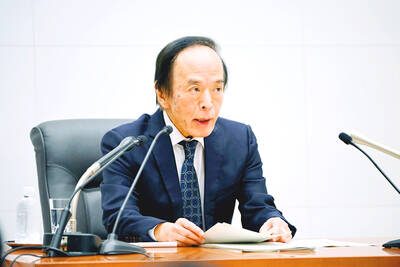Electronics supplier Lite-On Technology Corp (光寶科技) gave a dim outlook for the second half of this year, saying a persistent shortage of key components is likely to dampen demand.
While sales in the second half are expected to exceed takings in the first six months, it could take up to two years for the global technology sector to resolve lingering shortages in semiconductor materials and passive modules, Lite-On chief executive Warren Chen (陳廣中) told shareholders at the company’s annual general meeting on Friday last week.
The shortages are caused by growing demand for automotive electronics, Chen said, adding that end-user product pricing would only go up as businesses pass higher component costs on to consumers and drive down spending.
It would also be more difficult for Chinese manufacturers to make up the shortfall as Beijing tightens environmental standards, he said.
The extent of the component shortfall would become clearer in the third quarter as companies ramp up inventory in time for the back-to-school shopping season, Chen said.
Lite-On’s products mostly use standard specification passive modules, so the scarcity of components would have a limited effect on the company, he said.
However, the shortage has already caused a 1.9 percentage point decline in gross margin in the first quarter, while net income during the period fell to NT$1.04 billion (US$34.32 million), marking the company’s poorest showing for the January-to-March period since 2009, Chen said.
Regarding the escalating US-China trade dispute, Chen said that the company’s exposure would be limited to US-bound shipments of LED components and optical disk drives, with both categories representing only a small percentage of its total revenues.
Meanwhile, the company has made plans to continue expanding into the Chinese market for server storage through its 45 percent-owned Suzhou-based joint venture with China’s Tsinghua Unigroup Ltd (清華紫光).
The company said it would also boost its efforts to optimize smart manufacturing and automation.
Shareholders approved the company’s proposal to distribute a cash dividend of NT$2.92 per share.
That represents a payout ratio of 258 percent based on last year’s earnings of NT$1.13 per share and a yield of 7.69 percent on its closing price of NT$37.95 in Taipei trading on Friday.

Taiwan’s long-term economic competitiveness will hinge not only on national champions like Taiwan Semiconductor Manufacturing Co. (TSMC, 台積電) but also on the widespread adoption of artificial intelligence (AI) and other emerging technologies, a US-based scholar has said. At a lecture in Taipei on Tuesday, Jeffrey Ding, assistant professor of political science at the George Washington University and author of "Technology and the Rise of Great Powers," argued that historical experience shows that general-purpose technologies (GPTs) — such as electricity, computers and now AI — shape long-term economic advantages through their diffusion across the broader economy. "What really matters is not who pioneers

In a high-security Shenzhen laboratory, Chinese scientists have built what Washington has spent years trying to prevent: a prototype of a machine capable of producing the cutting-edge semiconductor chips that power artificial intelligence (AI), smartphones and weapons central to Western military dominance, Reuters has learned. Completed early this year and undergoing testing, the prototype fills nearly an entire factory floor. It was built by a team of former engineers from Dutch semiconductor giant ASML who reverse-engineered the company’s extreme ultraviolet lithography (EUV) machines, according to two people with knowledge of the project. EUV machines sit at the heart of a technological Cold

TAIWAN VALUE CHAIN: Foxtron is to fully own Luxgen following the transaction and it plans to launch a new electric model, the Foxtron Bria, in Taiwan next year Yulon Motor Co (裕隆汽車) yesterday said that its board of directors approved the disposal of its electric vehicle (EV) unit, Luxgen Motor Co (納智捷汽車), to Foxtron Vehicle Technologies Co (鴻華先進) for NT$787.6 million (US$24.98 million). Foxtron, a half-half joint venture between Yulon affiliate Hua-Chuang Automobile Information Technical Center Co (華創車電) and Hon Hai Precision Industry Co (鴻海精密), expects to wrap up the deal in the first quarter of next year. Foxtron would fully own Luxgen following the transaction, including five car distributing companies, outlets and all employees. The deal is subject to the approval of the Fair Trade Commission, Foxtron said. “Foxtron will be

INFLATION CONSIDERATION: The BOJ governor said that it would ‘keep making appropriate decisions’ and would adjust depending on the economy and prices The Bank of Japan (BOJ) yesterday raised its benchmark interest rate to the highest in 30 years and said more increases are in the pipeline if conditions allow, in a sign of growing conviction that it can attain the stable inflation target it has pursued for more than a decade. Bank of Japan Governor Kazuo Ueda’s policy board increased the rate by 0.2 percentage points to 0.75 percent, in a unanimous decision, the bank said in a statement. The central bank cited the rising likelihood of its economic outlook being realized. The rate change was expected by all 50 economists surveyed by Bloomberg. The